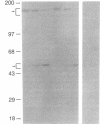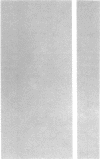Abstract
The presence of antiidiotypic antibodies (ab-2) to sperm was investigated in the sera of fertile, infertile, and virgin women using sperm-specific anti-FA-1 monoclonal antibody Fab'.ab-2 were detected in 71% (17/24) of sera from fertile women and in none (0/12) of the sera from virgin females by the enzyme-linked immunosorbent assay, Western blot procedure, and immunoprecipitation procedure. Sera from infertile women that had antisperm antibodies showed a minimal presence of ab-2, with only three sera (13%, 3/23) demonstrating the presence of low levels of ab-2. The ab-2 present in fertile women were capable of neutralizing the fertilization-inhibitory activity of anti-FA-1 antibody in a concentration-dependent manner in a human sperm penetration assay (SPA) of zona-free hamster oocytes. ab-2 were also capable of inhibiting the binding of antisperm antibodies to the sperm surface as determined by the immunobead binding technique. This is the first report demonstrating the presence of ab-2 in the sera of fertile women that are capable of neutralizing antisperm antibodies present in sera of infertile women. These findings suggest that the inability to detect antisperm antibody activity in the sera of fertile women may be due to higher levels of ab-2 present in these sera than levels found in sera of infertile women, although both groups may be producing antisperm antibody response after sexual exposure to sperm.
Full text
PDF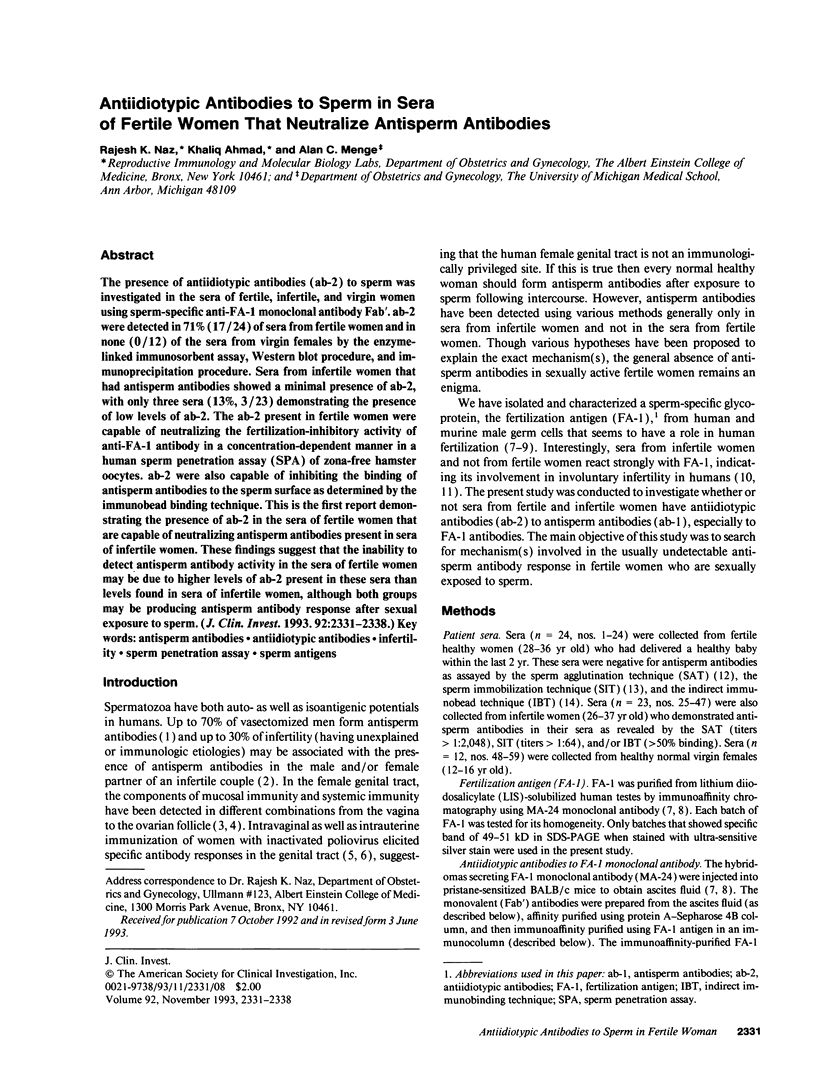

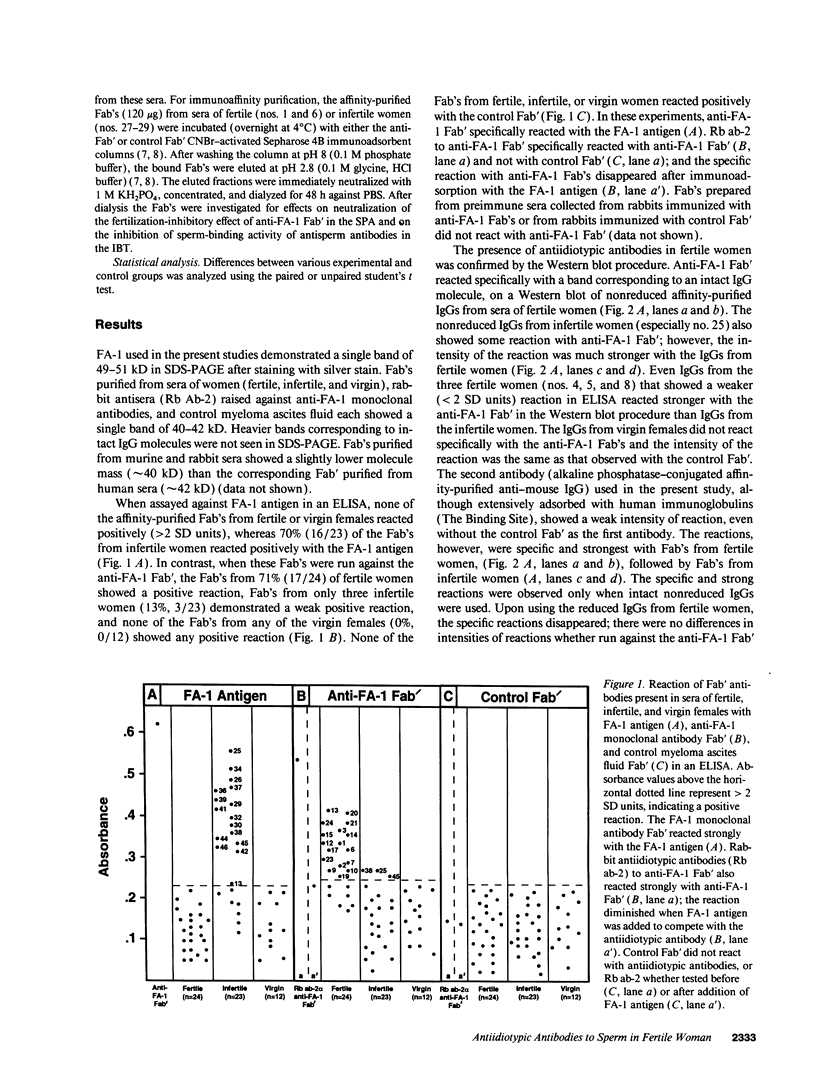
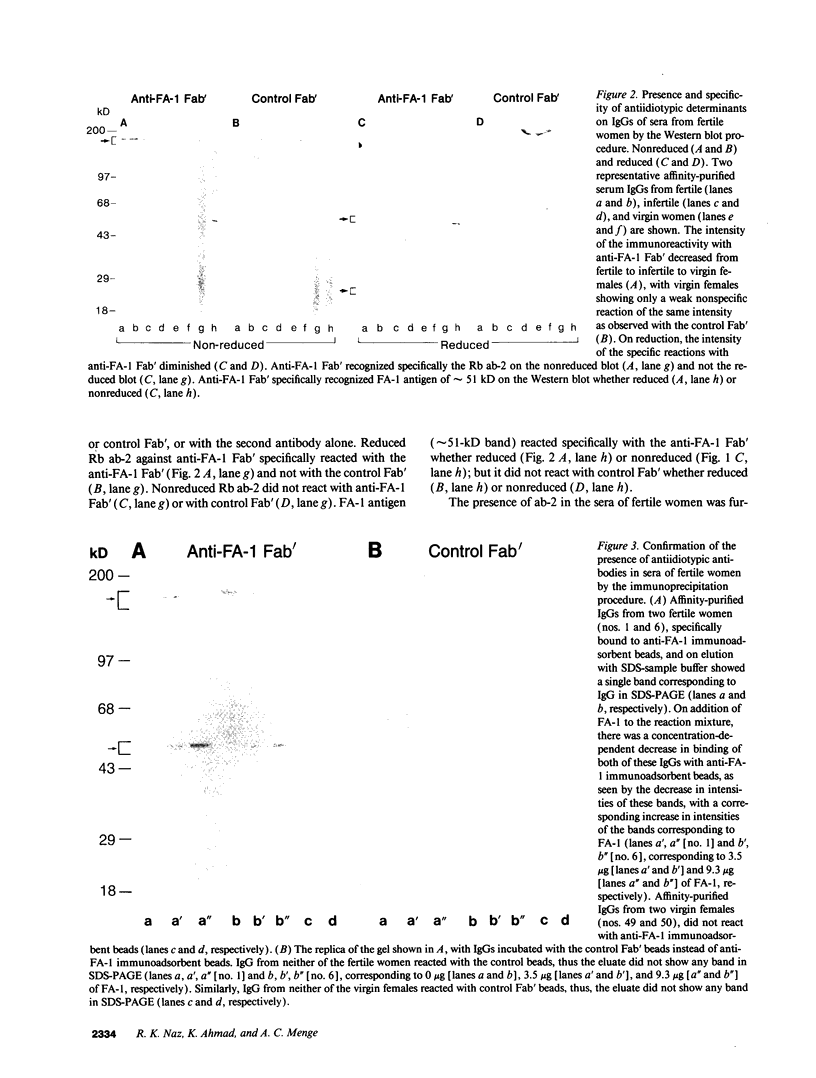
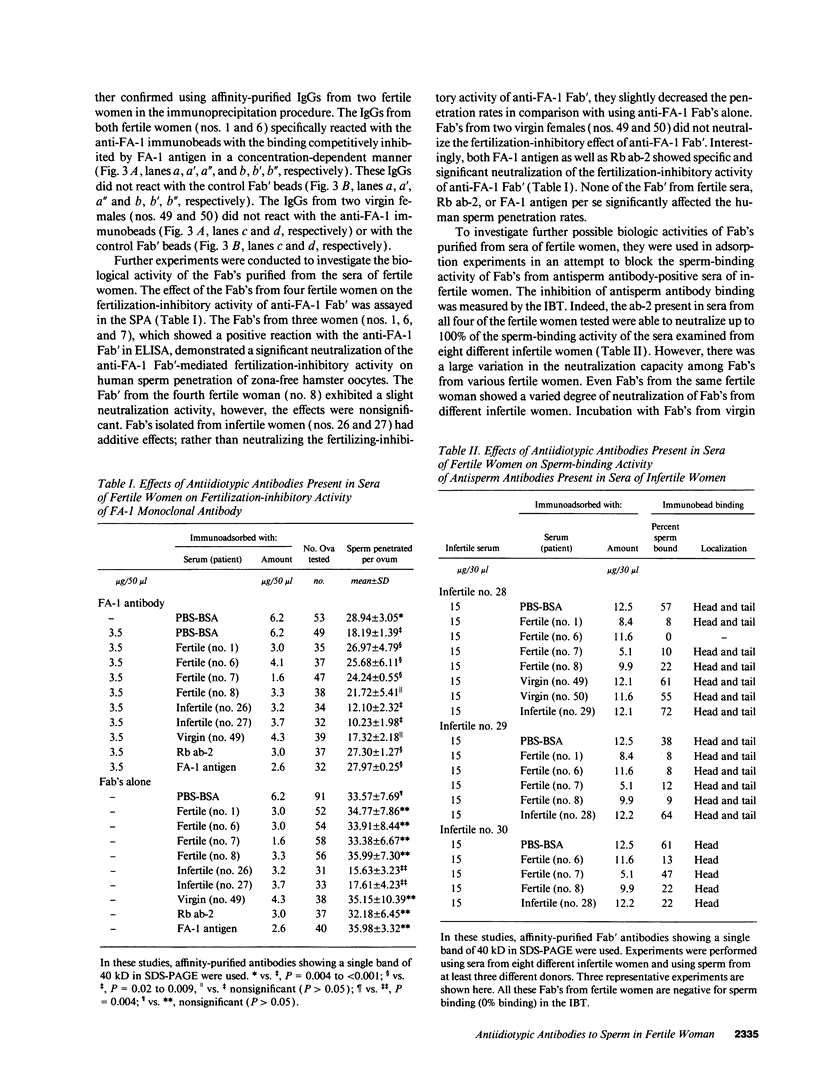

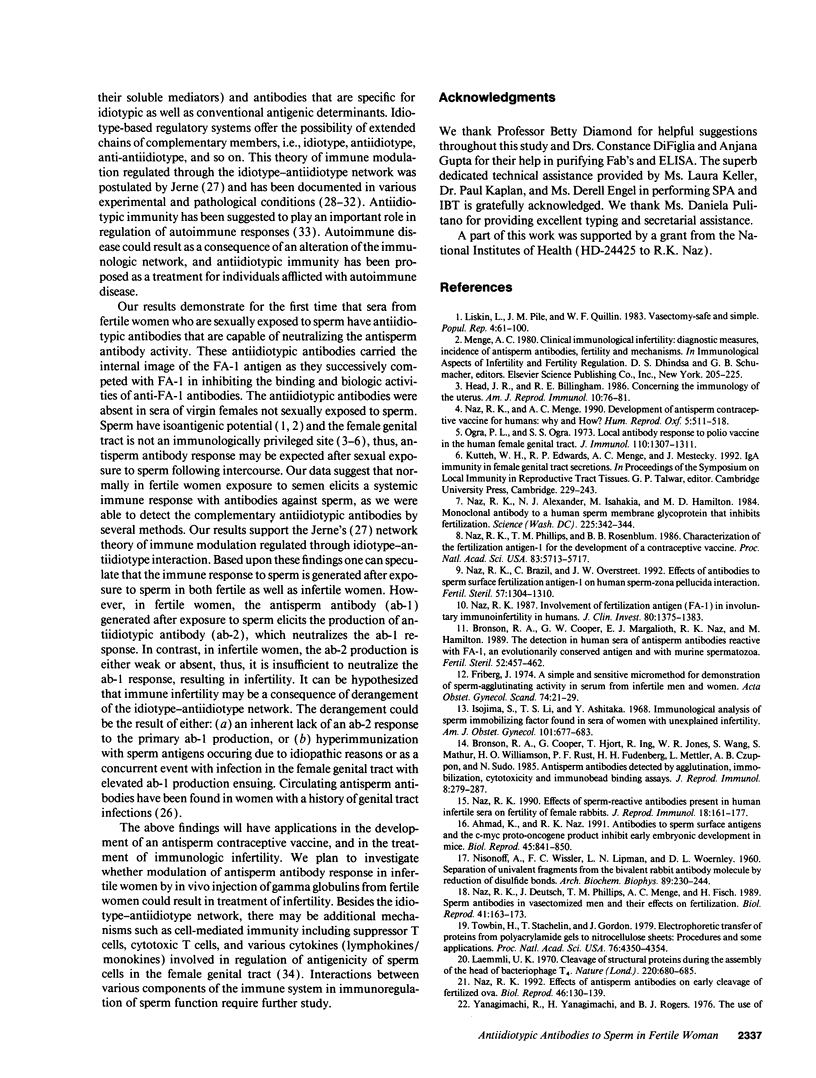
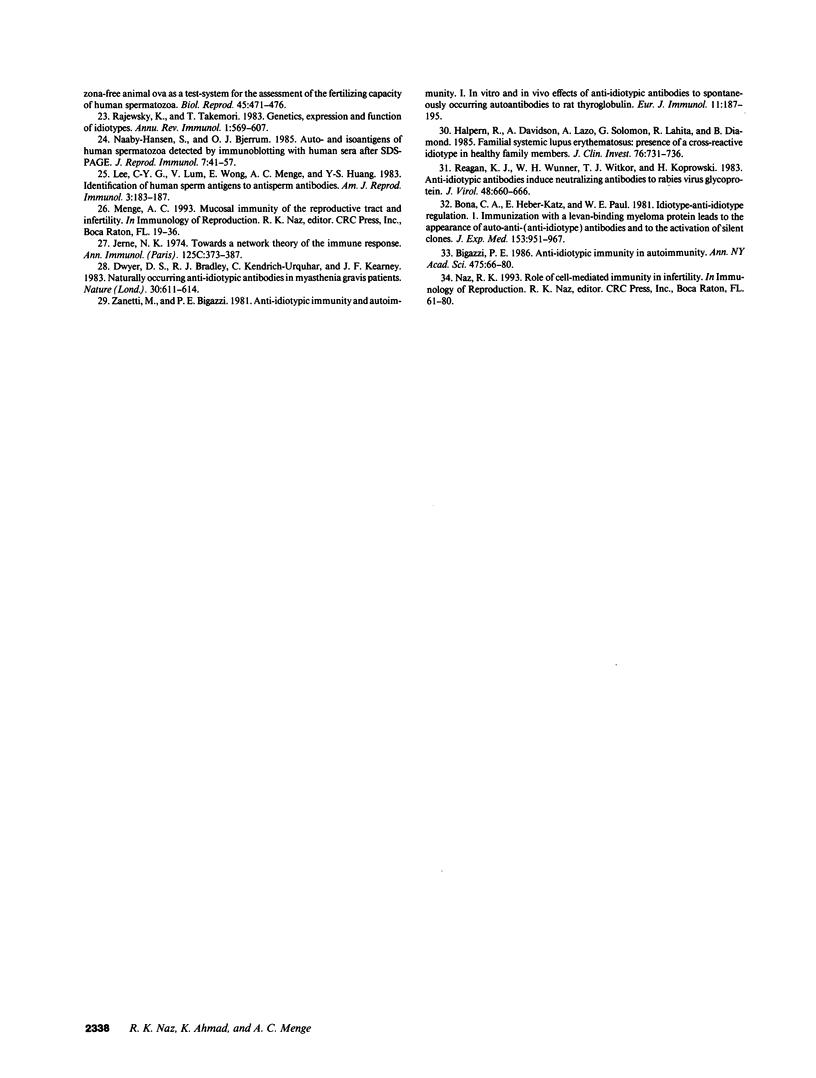
Images in this article
Selected References
These references are in PubMed. This may not be the complete list of references from this article.
- Ahmad K., Naz R. K. Antibodies to sperm surface antigens and the c-myc proto-oncogene product inhibit early embryonic development in mice. Biol Reprod. 1991 Dec;45(6):841–850. doi: 10.1095/biolreprod45.6.841. [DOI] [PubMed] [Google Scholar]
- Bigazzi P. E. Anti-idiotypic immunity in autoimmunity. Ann N Y Acad Sci. 1986;475:66–80. doi: 10.1111/j.1749-6632.1986.tb20857.x. [DOI] [PubMed] [Google Scholar]
- Bona C. A., Heber-Katz E., Paul W. E. Idiotype-anti-idiotype regulation. I. Immunization with a levan-binding myeloma protein leads to the appearance of auto-anti-(anti-idiotype) antibodies and to the activation of silent clones. J Exp Med. 1981 Apr 1;153(4):951–967. doi: 10.1084/jem.153.4.951. [DOI] [PMC free article] [PubMed] [Google Scholar]
- Bronson R. A., Cooper G. W., Margalioth E. J., Naz R. K., Hamilton M. S. The detection in human sera of antisperm antibodies reactive with FA-1, an evolutionarily conserved antigen, and with murine spermatozoa. Fertil Steril. 1989 Sep;52(3):457–462. doi: 10.1016/s0015-0282(16)60919-6. [DOI] [PubMed] [Google Scholar]
- Bronson R., Cooper G., Hjort T., Ing R., Jones W. R., Wang S. X., Mathur S., Williamson H. O., Rust P. F., Fudenberg H. H. Anti-sperm antibodies, detected by agglutination, immobilization, microcytotoxicity and immunobead-binding assays. J Reprod Immunol. 1985 Dec;8(4):279–299. doi: 10.1016/0165-0378(85)90003-8. [DOI] [PubMed] [Google Scholar]
- Friberg J. A simple and sensitive micro-method for demonstration of sperm-agglutinating activity in serum from infertile men and women. Acta Obstet Gynecol Scand Suppl. 1974;36:21–29. doi: 10.3109/00016347409156399. [DOI] [PubMed] [Google Scholar]
- Halpern R., Davidson A., Lazo A., Solomon G., Lahita R., Diamond B. Familial systemic lupus erythematosus. Presence of a cross-reactive idiotype in healthy family members. J Clin Invest. 1985 Aug;76(2):731–736. doi: 10.1172/JCI112028. [DOI] [PMC free article] [PubMed] [Google Scholar]
- Head J. R., Billingham R. E. Concerning the immunology of the uterus. Am J Reprod Immunol Microbiol. 1986 Mar;10(3):76–81. [PubMed] [Google Scholar]
- Jerne N. K. Towards a network theory of the immune system. Ann Immunol (Paris) 1974 Jan;125C(1-2):373–389. [PubMed] [Google Scholar]
- Laemmli U. K. Cleavage of structural proteins during the assembly of the head of bacteriophage T4. Nature. 1970 Aug 15;227(5259):680–685. doi: 10.1038/227680a0. [DOI] [PubMed] [Google Scholar]
- Lee C. Y., Lum V., Wong E., Menge A. C., Huang Y. S. Identification of human sperm antigens to antisperm antibodies. Am J Reprod Immunol. 1983 Jun;3(4):183–187. doi: 10.1111/j.1600-0897.1983.tb00243.x. [DOI] [PubMed] [Google Scholar]
- NISONOFF A., WISSLER F. C., LIPMAN L. N., WOERNLEY D. L. Separation of univalent fragments from the bivalent rabbit antibody molecule by reduction of disulfide bonds. Arch Biochem Biophys. 1960 Aug;89:230–244. doi: 10.1016/0003-9861(60)90049-7. [DOI] [PubMed] [Google Scholar]
- Naaby-Hansen S., Bjerrum O. J. Auto- and iso-antigens of human spermatozoa detected by immunoblotting with human sera after SDS-PAGE. J Reprod Immunol. 1985 Jan;7(1):41–57. doi: 10.1016/0165-0378(85)90020-8. [DOI] [PubMed] [Google Scholar]
- Naz R. K., Alexander N. J., Isahakia M., Hamilton M. S. Monoclonal antibody to a human germ cell membrane glycoprotein that inhibits fertilization. Science. 1984 Jul 20;225(4659):342–344. doi: 10.1126/science.6539947. [DOI] [PubMed] [Google Scholar]
- Naz R. K., Brazil C., Overstreet J. W. Effects of antibodies to sperm surface fertilization antigen-1 on human sperm-zona pellucida interaction. Fertil Steril. 1992 Jun;57(6):1304–1310. doi: 10.1016/s0015-0282(16)55092-4. [DOI] [PubMed] [Google Scholar]
- Naz R. K., Deutsch J., Phillips T. M., Menge A. C., Fisch H. Sperm antibodies in vasectomized men and their effects on fertilization. Biol Reprod. 1989 Jul;41(1):163–173. doi: 10.1095/biolreprod41.1.163. [DOI] [PubMed] [Google Scholar]
- Naz R. K. Effects of antisperm antibodies on early cleavage of fertilized ova. Biol Reprod. 1992 Jan;46(1):130–139. doi: 10.1095/biolreprod46.1.130. [DOI] [PubMed] [Google Scholar]
- Naz R. K. Effects of sperm-reactive antibodies present in human infertile sera on fertility of female rabbits. J Reprod Immunol. 1990 Sep;18(2):161–177. doi: 10.1016/0165-0378(90)90014-w. [DOI] [PubMed] [Google Scholar]
- Naz R. K. Involvement of fertilization antigen (FA-1) in involuntary immunoinfertility in humans. J Clin Invest. 1987 Nov;80(5):1375–1383. doi: 10.1172/JCI113215. [DOI] [PMC free article] [PubMed] [Google Scholar]
- Naz R. K., Phillips T. M., Rosenblum B. B. Characterization of the fertilization antigen 1 for the development of a contraceptive vaccine. Proc Natl Acad Sci U S A. 1986 Aug;83(15):5713–5717. doi: 10.1073/pnas.83.15.5713. [DOI] [PMC free article] [PubMed] [Google Scholar]
- Naz R., Menge A. Development of antisperm contraceptive vaccine for humans: why and how? Hum Reprod. 1990 Jul;5(5):511–518. doi: 10.1093/oxfordjournals.humrep.a137134. [DOI] [PubMed] [Google Scholar]
- Ogra P. L., Ogra S. S. Local antibody response to poliovaccine in the human female genital tract. J Immunol. 1973 May;110(5):1307–1311. [PubMed] [Google Scholar]
- Rajewsky K., Takemori T. Genetics, expression, and function of idiotypes. Annu Rev Immunol. 1983;1:569–607. doi: 10.1146/annurev.iy.01.040183.003033. [DOI] [PubMed] [Google Scholar]
- Reagan K. J., Wunner W. H., Wiktor T. J., Koprowski H. Anti-idiotypic antibodies induce neutralizing antibodies to rabies virus glycoprotein. J Virol. 1983 Dec;48(3):660–666. doi: 10.1128/jvi.48.3.660-666.1983. [DOI] [PMC free article] [PubMed] [Google Scholar]
- Towbin H., Staehelin T., Gordon J. Electrophoretic transfer of proteins from polyacrylamide gels to nitrocellulose sheets: procedure and some applications. Proc Natl Acad Sci U S A. 1979 Sep;76(9):4350–4354. doi: 10.1073/pnas.76.9.4350. [DOI] [PMC free article] [PubMed] [Google Scholar]
- Yanagimachi R., Yanagimachi H., Rogers B. J. The use of zona-free animal ova as a test-system for the assessment of the fertilizing capacity of human spermatozoa. Biol Reprod. 1976 Nov;15(4):471–476. doi: 10.1095/biolreprod15.4.471. [DOI] [PubMed] [Google Scholar]
- Zanetti M., Bigazzi P. E. Anti-idiotypic immunity and autoimmunity. I. In vitro and in vivo effects of anti-idiotypic antibodies to spontaneously occurring autoantibodies to rat thyroglobulin. Eur J Immunol. 1981 Mar;11(3):187–195. doi: 10.1002/eji.1830110306. [DOI] [PubMed] [Google Scholar]




